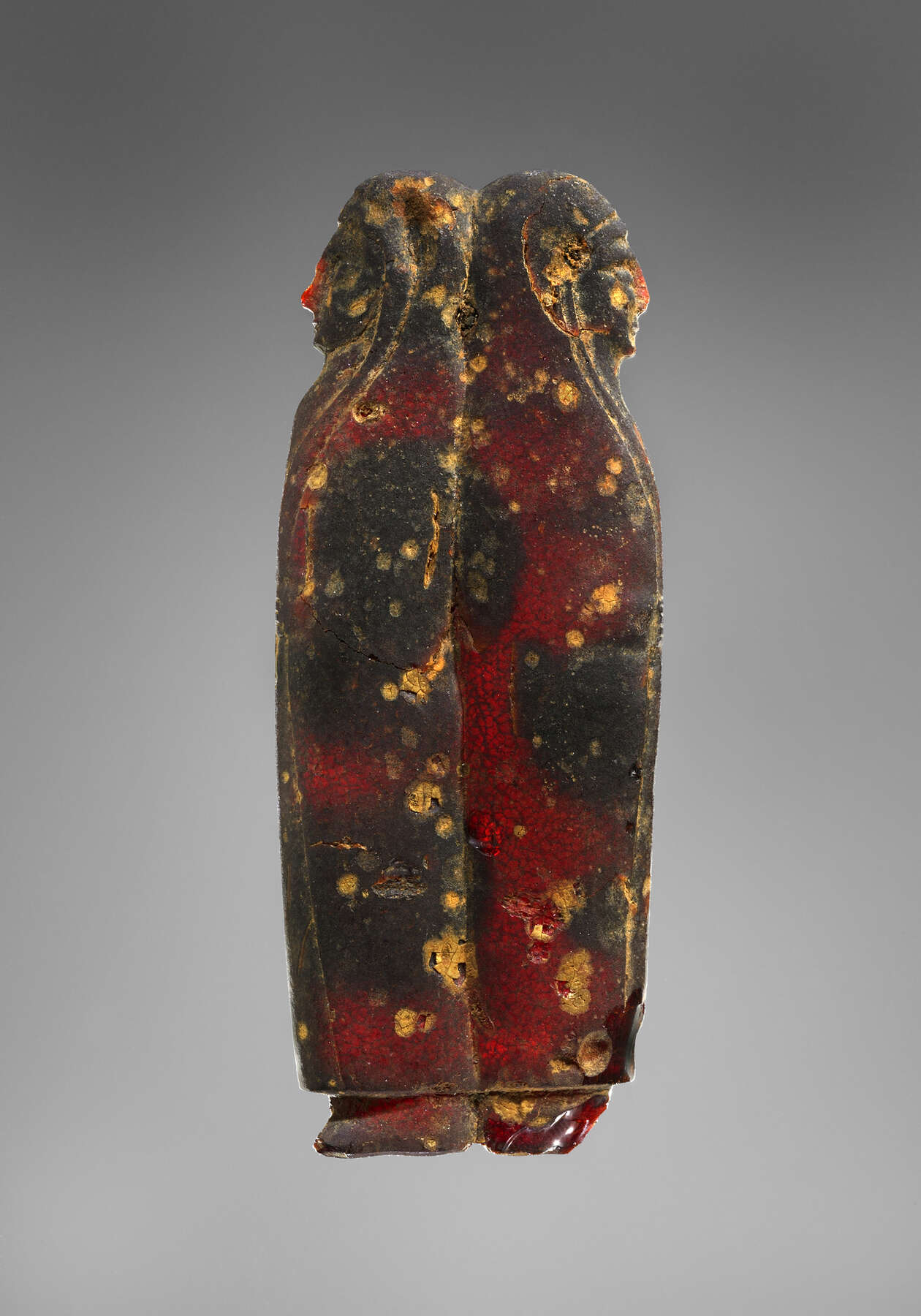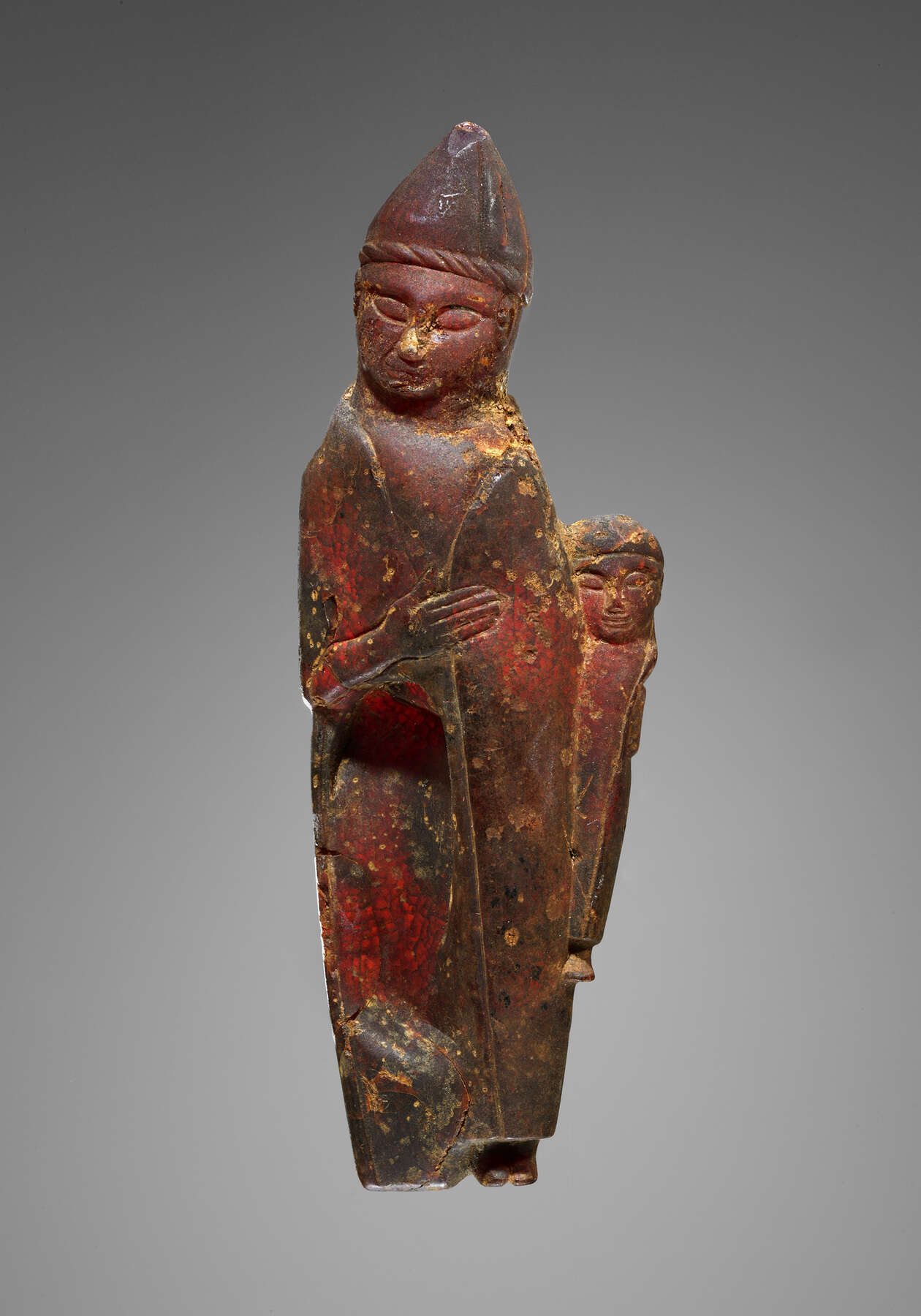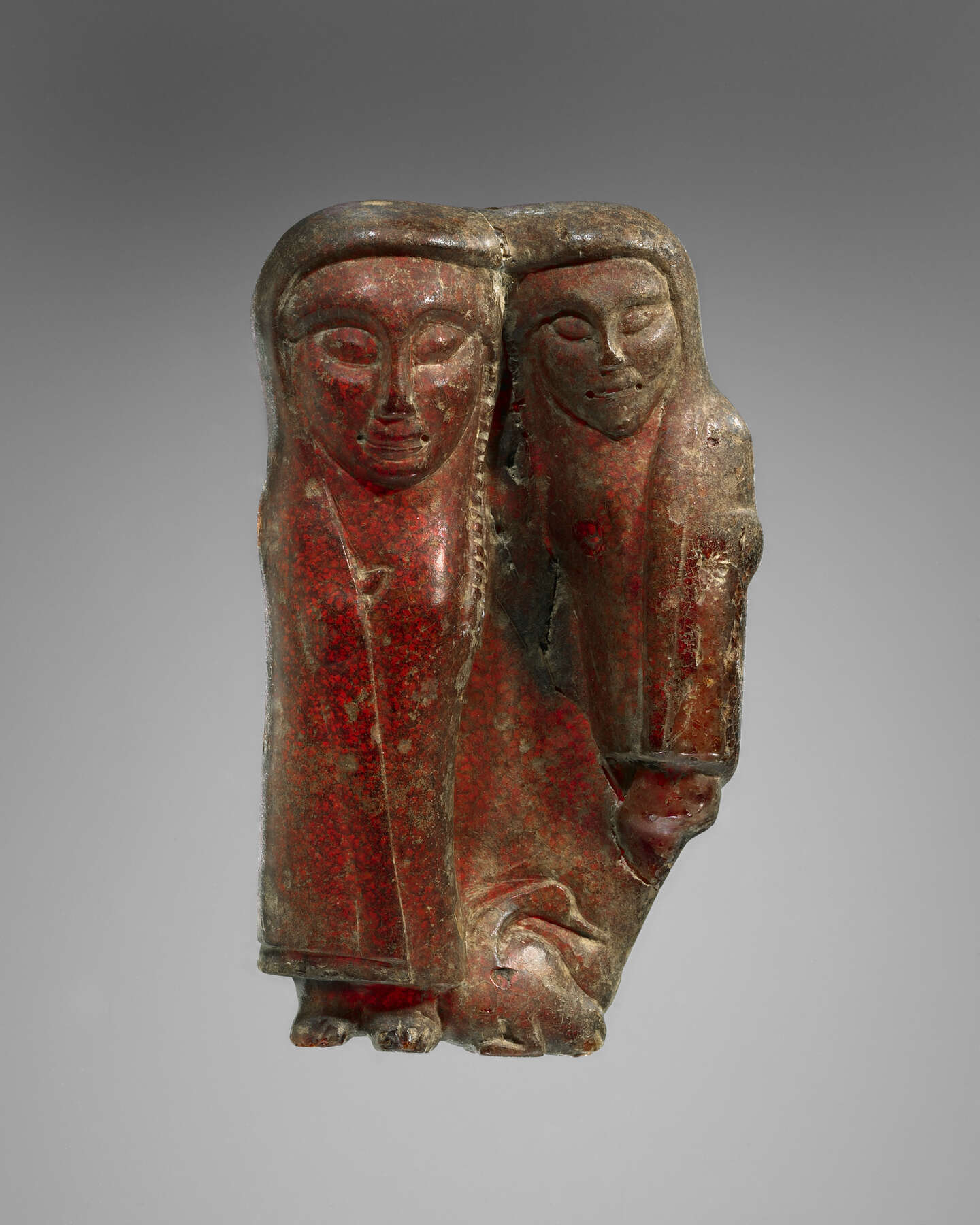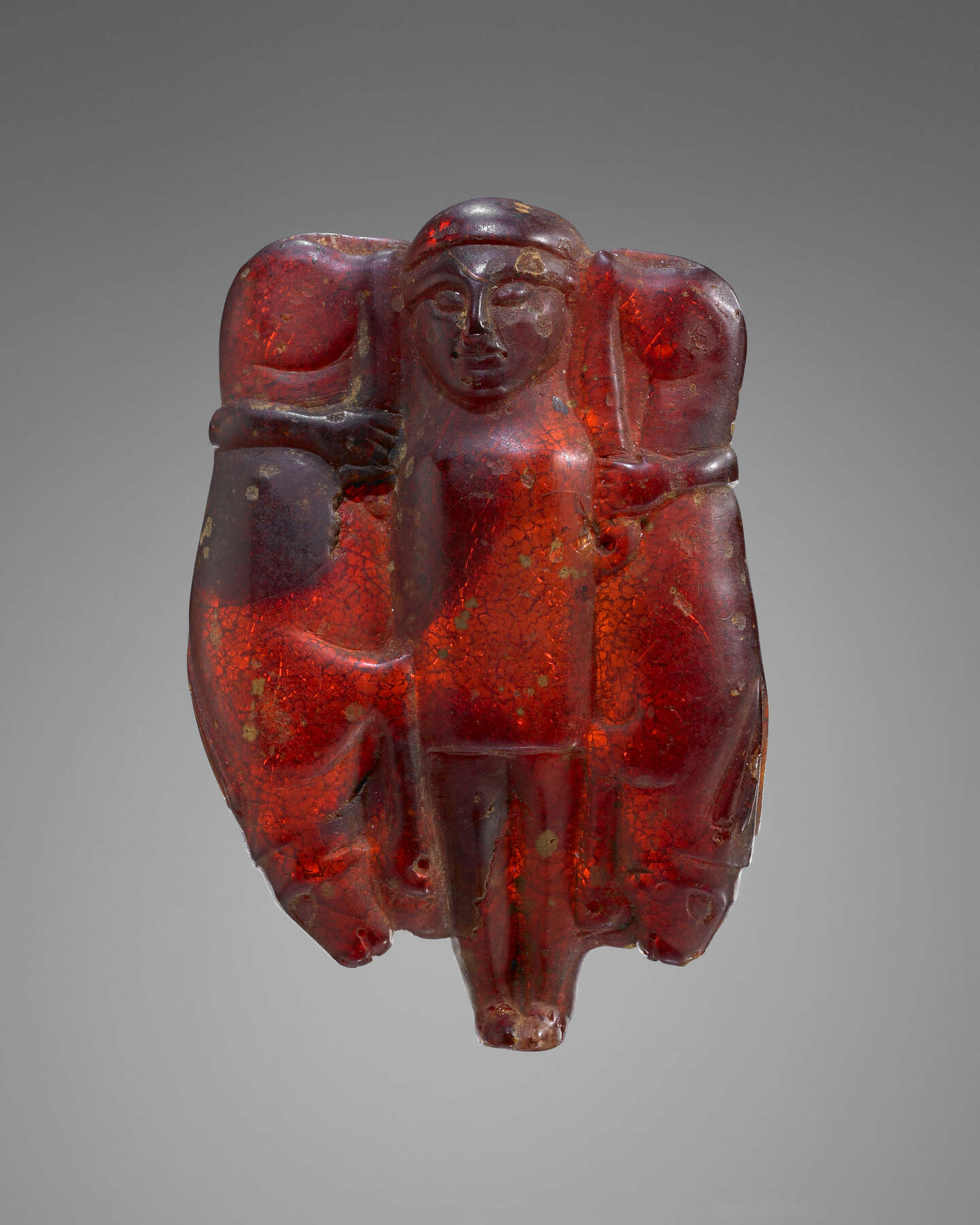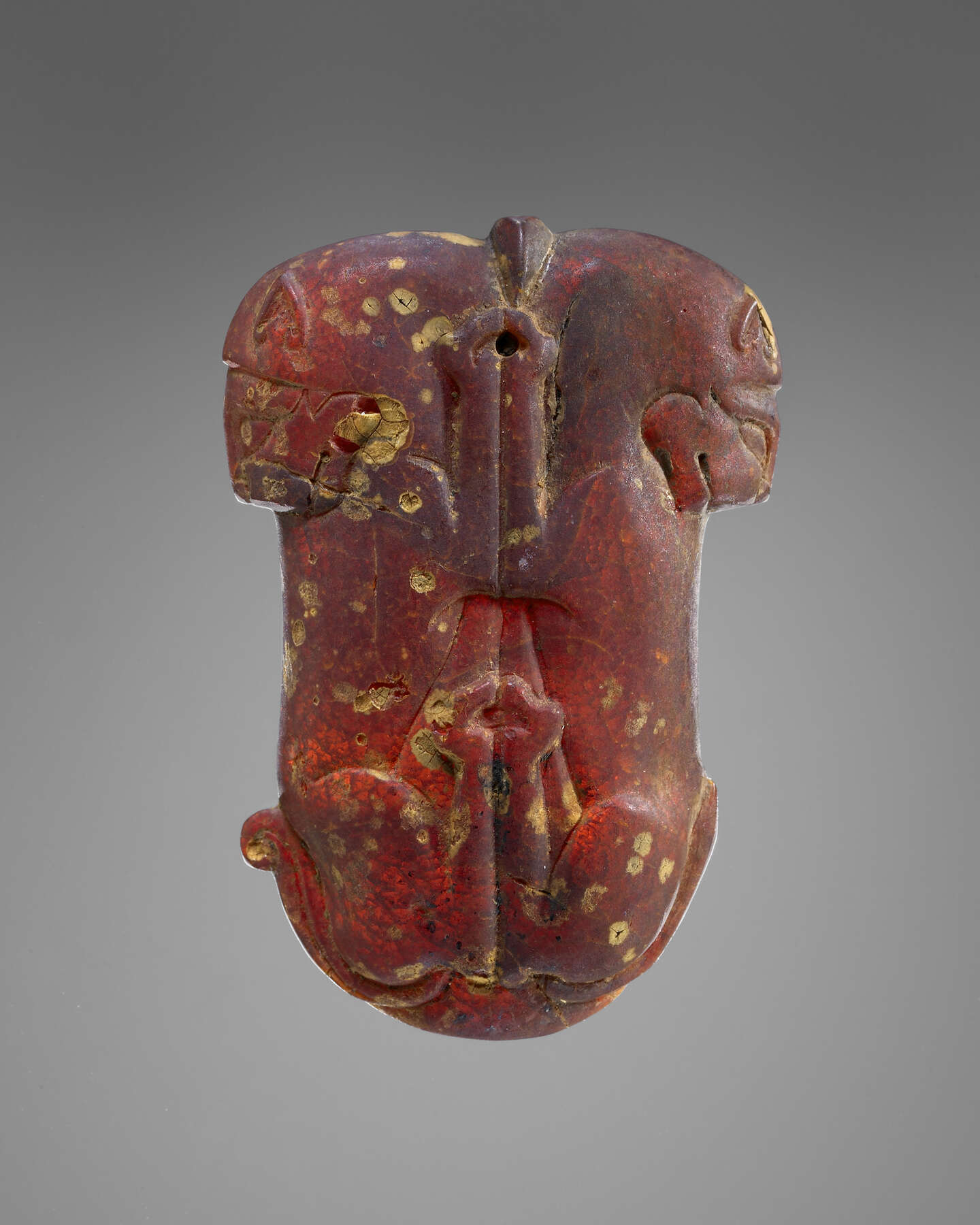3. Pendant: Addorsed Females
| Accession Number | 77.AO.81.1 |
| Culture | Etruscan |
| Date | 600–550 B.C. |
| Dimensions | Height: 100.4 mm; width: 39.9 mm; depth: 13 mm; Diameter of suspension holes: 2.5 mm; Weight: 39.3 g |
| Subjects | Egypt; Etruscan culture; Magic |
Provenance
–1977, Gordon McLendon (Dallas, TX), donated to the J. Paul Getty Museum, 1977.
Condition
The pendant is intact and in good condition. Although its two sides mirror each other, the obverse is distinguished by a more plastic rendering of the figures and superior carving, especially of the left-hand figure (hereafter referred to as Figure A). Figure A has minor chips on the reverse shoulder and small breaks on the feet at the hem area. Figure B has a chip on the reverse shoulder. The piece is a dark reddish brown color in ambient light and is dark ruby-red in transmitted light. There are many large inclusions, including those at the heads, torsos, knees, and feet of both figures.
Description
The pendant is carved from a relatively flat piece of amber and represents two figures standing back to back. An indentation and an engraved line separate the rigidly posed, profiled figures. The two figures are identified as females because of their facial characteristics and dress. Although similar, they are not identical: the faces are especially idiosyncratic.
On both sides of Figure A, the forehead-to-nose line is smooth, with only the slightest bulge at the brow ridge and a faint indentation for the root of the nose. The eyes are amygdaloidal, with the outer corners higher than the inner. The angle of the nose is close to the facial plane; the nose itself points slightly downward, and overhangs the level of the short chin. The upper lip area is short; the upper lip protrudes over the lower. The face of B is different: the forehead slopes more acutely; the root of the nose is more deeply indented; the nose is attached lower on the face; and the angle of the nose is farther from the facial plane. The eyes of Figure B are also almond-shaped but are narrower. The figure’s lips have an even profile. Her chin is short and small, and there is a hint of a double chin. The mouth furrow, cheek modeling, and area under the chin are features that make Figure B appear older than A.
The two wear the same type of dress, a long chiton that descends to the ankle; a tightly fitting veil, which covers the hair and falls to the hem; and a heavy, ankle-length cloak. There is no indication of hair on either woman. Swellings and indentations on the surface of the piece describe the shape of the arms and upper torsos. Each figure places one hand flush on the chest and with the other holds the left edge of her garment at the waist area. Figure A has her right hand up and the left below; Figure B has her left hand above and the right below. The small feet of Figure B are pointed, without any toes delineated, suggesting that both figures were meant to be represented as shod. (The toe area of Figure A is broken off.)
Tool marks include visible abrasion traces in the sections closest to the engraved line that separates the two figures, at the necks, and at the ankles. The perforation for suspension passes from front to back at the center of the pendant, at the nape of each figure’s neck.
Discussion
This amber pendant is unique in composition and iconography. The combination of dress elements worn by the figures of 77.AO.81.1—the long chiton, veil, and heavy, enveloping overgarment, Emeline Richardson’s Heavy Cloak—is otherwise unattested. Generally, the best parallels for the figures of 77.AO.81.1 are the two other pendants from this group with standing female figures— (cat. no. 1) and (cat. no. 2)—and their comparanda, including the group of four ambers likely from Ascoli Piceno in Philadelphia (University of Pennsylvania, Museum of Archaeology and Anthropology)1 and the pendant of two standing figures in London.2 The female figure in the latter, also presented in profile, is especially close in physical type and dress, although she is of a huskier physical type. 77.AO.81.1 also has correspondences with three other kinds of archaeological material: Etruscan bronzes, ivory and bone carvings, and bucchero ware. In each case, the traditions informing the imagery are similar.
The votive bronzes most like 77.AO.81.1 are in Richardson’s Early Etruscan Ladies Series,3 the same group that provides good parallels for (cat. no. 4), , and . Three, now in London, Leiden, and Florence, respectively, are the most similar.4 The salient parallel for 77.AO.81.1 is the last, Florence 27, which is the latest in Richardson’s B Series. The sculptural contours and facial profiles are nearly identical, and, in both cases, the shawl curves over the forehead in the same way. The small feet are also comparable, although the Florence bronze wears calceoli repandi (curled-toe boots)5 rather than the simple boots of the amber women. British Museum 1907.3–11.1, among the earliest in the Ladies Series, is most like the figures of 77.AO.81.1 in facial type, in the small, articulated hands, and in the shod feet. The Leiden bronze is most similar in dress. Although more simply rendered than on 77.AO.81.1, it is the same garment.6
The ivory and bone carvings related to 77.AO.81.1 include an identical pair of bone plaques from a chair or other furnishing from a tomb at Belmonte Piceno, representing a large winged goddess flanked by two small female figures;7 and a number of bone pendants, one from the Large Building excavations at Poggio Civitate,8 and others, all votives, from the Stipe di Sant’Omobono, Rome.9 The small figures from the Picene bone plaques wear clothing different from that of 77.AO.81.1 but are similar in their arm and hand positions and their addorsed poses. The unique figure-seal from the Sant’Omobono deposit is analogous in style and figural type but differs in the position of the arms. The arms of all of the Sant’Omobono votives (and probably that of the Poggio Civitate pendant) hang at their sides.
The images of Potnia Theron decorating the handles of some Orientalizing bucchero kyathoi are significantly similar in format and style to 77.AO.81.1. The figural type, proportions, and modeling are comparable to a series of kyathoi handles from Poggio Civitate,10 and to another type found at several sites, but which, too, may have originated at Chiusi. This type is adorned with images of a full-figured Potnia Theron who is winged and holds long-necked birds.11
There are few carved ambers formed into doubled subjects, but among them is another work from the same Getty group, Paired Lions (, cat. no. 6). Two other approximately contemporary examples, both Picene, are the fragmentary pendant with addorsed figures from Castelbellino12 and the Philadelphia pendant (MS 2538) in the form of a draped standing female backed with a nude figure.13 Earlier doubled-figure compositions in amber include the Getty Addorsed Sphinxes (, cat. no. 28) and a number of the pendants from Tomb VI at Satricum (circa 640–630 B.C.): two pairs of twinned nude females, a pair of twinned, possibly masked figures, a seated monkey with a small, fetuslike, possibly human figure on his head, and two pendants of conjoined foreparts, one a lion-centaur and the other a lion and (perhaps) dog.14 Two parallels much later than 77.AO.81.1, dating to the fourth century B.C., are pendants of addorsed human heads. One is the central pendant of a votive necklace from the sanctuary of the goddess Mefite in the Valle d’Ansanto (a rare example of a figured amber excavated from a sanctuary),15 and the second a nearly identical pendant, also from a string of very similar-looking amber human-head pendants.16
Addorsed compositions and doubling generally were already age-old by the sixth century B.C. Doubled figures, some addorsed, are not uncommon among ivory and bone carvings from Egypt, the Near East, and the Phoenician world. This compositional motif was often used for objects such as handles17 and pommels, as well as in weaving or embroidery. Doubled images may represent the same figure twice or two different figures. Doubling and twinning may always have been inherently magical. The doubling of a phrase in a magical spell was understood to increase its efficacy, and the same may have been true for imagery. In amulet making, doubling and addorsed compositions were well-established conventions.18
Many kinds of objects in the ancient world include two figures represented side by side, in both seated and standing poses, but addorsed compositions are rare. Among the exceptions are terracotta vessels, bone and ivory carvings, and the above-noted ambers. In some cases, the figures are identical; in others, they are distinct.19 The significance of the addorsed pose is not clear.20
In Egypt, as C. Desroches Noblecourt points out, addorsed figures are a convention used to represent figures that are actually side by side.21 Stelae of the New Kingdom and later periods frequently show two deities back to back.22 The conscious pattern seen in the countless examples of paired deities, other figures, or symbols is unmistakable. As Richard Wilkinson observes, “Often in fact, a pair of deities—especially goddesses—are depicted identically in dress and appearance and differ only in name, as though their very duality gave them significance enough.”23 One Etruscan example is a funerary object from Orvieto dating to the second half of the sixth century, a tufa cippus in the form of back-to-back busts of female figures, likely sphinxes, and a suitably Egyptian subject for an addorsed composition.24
Objects with identical addorsed female subjects in Egyptian, Eastern Mediterranean, and Orientalizing Greek art may point the way for further study of the meaning of the subject type in Italy. Because 77.AO.81.1 is made of amber, the figures must be divinities, heroines, or demons. The hand gestures of the pair may emphasize the fertility and funerary aspects of the amber. If a divine subject, the pendant may represent a “duplicate divinity.” That is, as T. Hadzisteliou Price has summed up, a doubled divine image may represent one deity with two names or two aspects, natures, or cults; a deity that appears in the plural, such as the Eileithyiai; or a duplication of one goddess for the purpose of strengthening the deity’s quality.25 However, because of the subtle differences between the two figures of 77.AO.81.1, it may be that the pendant represents a dyad: that is, two discrete divine individuals.
Notes
- . ↩
- , pp. 66–67, no. 43, pl. XIX. ↩
- , p. 45. ↩
- British Museum 1907.3–11.1; Leiden, Rijksmuseum van Oudheden H3 ZZZZ 1 (from Montalcino in Chiusine territory); Florence, Museo Archeologico Nazionale 27. ↩
- The famous Etruscan curled-toed footwear does not appear in Etruria earlier than the second quarter of the sixth century B.C. See , pp. 60–62; and , p. 47 (see also introduction to part 2, p. 33, no. 11). ↩
- For a discussion of the garment, see , pp. 45ff.; and , p. 46. ↩
- Ancona, Museo Archeologico Nazionale 1154 (from Belmonte Piceno Tomb 83): , pp. 135–36. ↩
- Poggio Civitate, Antiquarium 71–100: , p. 78, fig. 121. ↩
- Rome, Antiquario Comunale (bone figures from the Stipe di Sant’Omobono) 27876 (single figure) and 27877 (figure-seal): , pp. 276–77, 10.18.c 7,6. The seal has a flat, square base engraved on its underside with a lion in whose maw is a human leg. Attached to the head of the figure-seal is a large, disklike flange, perforated for suspension. The flange may derive from the sun disk worn by some Egyptian deities; it recalls the sun disk–like appendages on some bronzes from Satricum. See , p. 267, for references to three bronzes with head appendages from Satricum in the Villa Giulia (Museo Nazionale Etrusco di Villa Giulia 10513–18, 110922). She presumes all these images to be of the Mater Matuta herself. The disk and the lion of the Sant’Omobono figure-seal may be interpreted as links to Hathor. ↩
- , pp. 47, 97, no. 35, fig. 17, pl. 11 (his Winged Goddess Type 1, with Murlo nos. 73268–69). ↩
- The full-figured type was excavated at Poggio Civitate: see , pp. 46–47, no. 34, fig. 16, pl. 10 (his Winged Goddess Type 2, with parallels at Pescia Romana, Ischia di Castro, Vulci, and Poggio Buco). Owls perch above the latter type. Another bucchero comparison is to be found in the mirrored, addorsed female heads (of a long-haired Daidalic phenotype) decorating the handle crests of another type of kyathos. One example of this addorsed-heads phenotype was excavated at Poggio Civitate: see , p. 45, no. 31, fig. 15, pl. 9 (with parallels cited from Cortona, Chiusi, and Vulci). ↩
- , cols. 413–14, fig. 46. ↩
- Philadelphia, University of Pennsylvania, Museum of Archaeology and Anthropology MS 2538: , no. 2, figs. 13.4–6; , p. 226, no. 241. ↩
- Museo Nazionale Etrusco di Villa Giulia 12024–26, 12028, 12033. The definitive study is . For twinned figures, see his pp. 438–41. For the Picene amber, see . Waarsenburg allows the possibility that the figures are masked and compares them to vessels isolated by R. De Puma, “Nude Dancers: A Group of Bucchero Pesante Oinochoai from Tarquinia,” in Proceedings of the 3rd Symposium on Ancient Greek and Related Pottery, Copenhagen, August 31–September 4, 1987, ed. J. Christiansen and T. Melander (Copenhagen, 1988), pp. 130–43. ↩
- The votive amber necklace with multiple profile female heads (at least six) from the sanctuary of the goddess Mefite (Valle d’Ansanto) is in the Museo Provinciale Irpino, Avellino. See , p. 210, n. 20; 30 (1976): 503–4, no. 1309g; and G. Colucci Pescatori, Il Museo Irpino (Cava dei Tirreni, 1975), p. 33, pl. IX. ↩
- This group of ambers was on the Zurich art market in 1981. ↩
- Perhaps related in meaning are eighth-century B.C. ivory handles in the form of addorsed, partially clothed females, including the closely related fan handle from Nimrud in the British Museum (WA 118102: , pp. 102–3, no. 1). Another ivory analogue is a janiform “Astarte” figurine excavated from a well at Kameiros (British Museum GR 1864.107.671), which L. Schofield suggests is a local Rhodian product made under the influence of Oriental ivory carving: see L. Schofield, “The Influence of the Eastern Religions on the Iconography of Ivory and Bone Objects in the Kameiros Well,” in , p. 174, pl. 1a. The tufa cippus with addorsed busts (possibly of nude female figures or sphinxes) from Orvieto is an important architectural manifestation of the schema (Florence, Museo Archeologico Nazionale 73138): , p. 87, no. 149. ↩
- Among the most common of Egyptian addorsed-figure amulets are those figured with the pataikos, joined with Bes or with a falcon-headed dwarf: see , p. 39. ↩
- Among the most notable examples of nonidentical figures are the East Greek terracotta alabastra in the form of two addorsed female figures. ↩
- Does the addorsed pose have a special antidemonic potency? , p. 364, notes that in European tales of witches’ sabbaths the participants are portrayed as dancing back to back instead of face to face. ↩
- , p. 189. ↩
- , p. 130. ↩
- Ibid. ↩
- The tufa cippus with addorsed busts (perhaps sphinxes) is Florence, Museo Archeologico Nazionale 73138: , p. 87, no. 149. ↩
- T. Hadzisteliou Price, “Double and Multiple Representations in Greek Art and Religious Thought,” 91 (1971): 48–69. See also V. von Graeve, “Neue archaische Skulpturenfunde aus Milet,” in Archaische und klassische griechische Plastik: Akten des internationalen Kolloquiums vom 22.–25. April 1985 in Athen, vol. 1 (Mainz, 1986), pp. 23–30; and C. Sourvinou-Inwood, “Reading” Greek Death to the End of the Classical Period (Oxford, 1995), p. 244. ↩
Bibliography
- Andrews 1994
- Andrews, C. Amulets of Ancient Egypt. Austin, TX, 1994.
- Bartoloni et al. 2000
- Bartoloni, G., et al., eds. Principi etruschi: Tra Mediterraneo ed Europa. Exh. cat. Bologna, 2000.
- Berkin 2003
- Berkin, J. M. The Orientalizing Bucchero from the Lower Building at Poggio Civitate (Murlo). Philadelphia, 2003.
- Bonfante 2003
- Bonfante, L. Etruscan Dress. Updated ed. Baltimore, 2003.
- Civiltà degli Etruschi 1985
- Cristofani, M, ed. Civiltà degli Etruschi. Exh. cat. Florence, 1985.
- Desroches-Noblecourt 2006
- Desroches-Noblecourt, C. Le secret des découvertes. Paris, 2006.
- Fitton 1992
- Fitton, J. L., ed. Ivory in Greece and the Eastern Mediterranean from the Bronze Age to the Hellenistic Period. London, 1992.
- Johnston 1995
- Johnston, S. I. “Defining the Dreadful: Remarks on the Greek Child-Killing Demon.” In Ancient Magic and Ritual Power, edited by M. Meyer and P. Mirecki, pp. 361–87. Leiden, 1995.
- Losi et al. 1993
- Losi, M., B. Raposso, and G. Ruggiero. “The Production of Amber Female Heads in Pre-Roman Italy.” In Amber in Archaeology: Proceedings of the Second International Conference on Amber in Archaeology, Liblice, 1990, edited by C. W. Beck and J. Bouzek, pp. 203–11. Prague, 1993.
- Marconi 1933
- Marconi, P. “La cultura orientalizzante nel Piceno.” 35 (1933): cols. 265–454.
- Phillips 1993
- Phillips, K. M., Jr. In the Hills of Tuscany: Recent Excavations at the Etruscan Site of Poggio Civitate (Murlo, Siena). Philadelphia, 1993.
- Richardson 1983
- Richardson, E. H. Etruscan Votive Bronzes: Geometric, Orientalizing, Archaic. 2 vols. Mainz am Rhein, 1983.
- Rocco 1999
- Rocco, G. Avori e ossi dal Piceno. Rome, 1999.
- Strong 1966
- Strong, D. E. Catalogue of the Carved Amber in the Department of the Greek and Roman Antiquities. London, 1966.
- World of the Etruscans 2001
- The World of the Etruscans. Exh. cat. Florence, 2001.
- Turfa 2005
- Turfa, J. Macintosh. Catalogue of the Etruscan Gallery of the University of Pennsylvania Museum of Archaeology and Anthropology. Philadelphia, 2005.
- Waarsenburg 1995
- Waarsenburg, D. J. The Northwest Necropolis of Satricum: An Iron Age Cemetery in Latium Vetus. Amsterdam, 1995.
- Warden 1994
- Warden, P. G. “Amber, Ivory, and the Diffusion of the Orientalizing Style along the Adriatic Coast: Italic Amber in the University Museum (Philadelphia).” In Murlo and the Etruscans: Art and Society in Ancient Etruria, edited by R. De Puma and J. P. Small, pp. 134–43. Madison, WI, 1994.
- Wilkinson 1994
- Wilkinson, R. H. Symbol and Magic in Egyptian Art. London, 1994.
